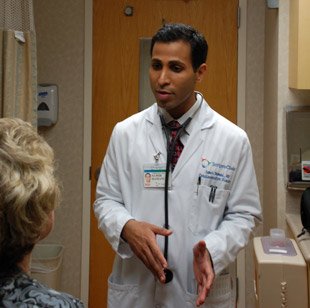History
 The “Wellderly” project represents one of Scripps Genomic Medicine’s key research areas: healthy aging. Photos and brief bios about some of the Wellderly participants are posted on the wall at the entrance to Scripps Translational Science Institute and Scripps Genomic Medicine.
The “Wellderly” project represents one of Scripps Genomic Medicine’s key research areas: healthy aging. Photos and brief bios about some of the Wellderly participants are posted on the wall at the entrance to Scripps Translational Science Institute and Scripps Genomic Medicine.
In 2006, Scripps Health launched both the Scripps Translational Science Institute (STSI) and Scripps Genomic Medicine (SGM) to change the status quo in medicine and help shape the future of health care as we know it.
To organize and lead both STSI and SGM, Scripps Health recruited one of the world’s premier cardiologists and physician/scientists, Eric J. Topol, M.D. Dr. Topol had enlisted three distinguished researchers (Samuel Levy, Ph.D., Sarah S. Murray, Ph.D., and Nicholas J. Schork, Ph.D) to join him in organizing and leading the institutes’ programs.
Scripps Genomic Medicine (SGM):
SGM is a prototypic program for multi-disciplinary research because of the diverse backgrounds of its leaders and governing boards.
The founders designed SGM to take advantage of the explosion of new knowledge and technologies from the government’s investment in the Human Genome Project. Under SGM, the founders have established a robust system for systematically discovering and characterizing DNA variants associated with human diseases. SGM, now part of STSI, reflects Scripps Health’s dedication to advancing patient care by tailoring prevention, diagnosis and treatment to an individual’s unique genomic signature.
Under SGM, we focus on the following key research areas, among many others:
- Pharmacogenomics
- Diabetes
- Cancer
- Biomarkers
- Healthy aging
For examples of studies in these key research areas, please visit Research Highlights.
Scripps Translational Science Institute (STSI):
 Former STSI clinical scholar Samir Damani, M.D., PharmD, talks with one of his Scripps Clinic patients. STSI’s education and training program is designed to equip physicians such as Dr. Damani with the knowledge and skills to succeed as a translational scientist.
Former STSI clinical scholar Samir Damani, M.D., PharmD, talks with one of his Scripps Clinic patients. STSI’s education and training program is designed to equip physicians such as Dr. Damani with the knowledge and skills to succeed as a translational scientist.
STSI hybridizes The Scripps Research Institute’s (TSRI) considerable biomedical science expertise with Scripps Health’s exceptional patient care and clinical research. The translational bridge between the TSRI and Scripps Health fosters innovative programs and methodology, provides an optimal setting for training and education and accelerates the conduct of studies that will have the greatest potential impact on the practice of health care in the clinic and the community.
While SGM research targets five key areas, STSI sponsors pilot/methodological studies that embrace a broader range of disease agnostic translational science. Examples of STSI’s pilot/methodological studies, which are designed to expedite the investigation of highly innovative research proposals with potential clinical impact, are at: Awarded Pilot Grants.
Because the creative, transformative blueprint for STSI requires dedicated space, a new building to house the institute was constructed on a site between the Scripps Clinic and TSRI. The 60,000 sq. ft. building, which was leased with an option to buy, was occupied in late 2007. STSI’s ultra-high throughput genotyping and sequencing resources remain in the 5,000 sq. ft. SGM labs in TSRI’s Department of Molecular and Experimental Medicine.
In May 2008, STSI received the highly competitive National Institutes of Health’s Clinical and Translational Science Award (CTSA). STSI was the first institution in Southern California that was awarded the CTSA and is still the only recipient that is not a university. The CTSA grant helps to amplify and insure the success of STSI by:
- providing meaningful critique and external peer review;
- linking with the other CTSA institutions to share expertise and develop best practices;
- engaging cross-talk on optimizing the research and learning environment;
- enabling education and training programs that otherwise STSI would not be capable of funding; and
- catalyzing the timelines and performance of the STSI.
